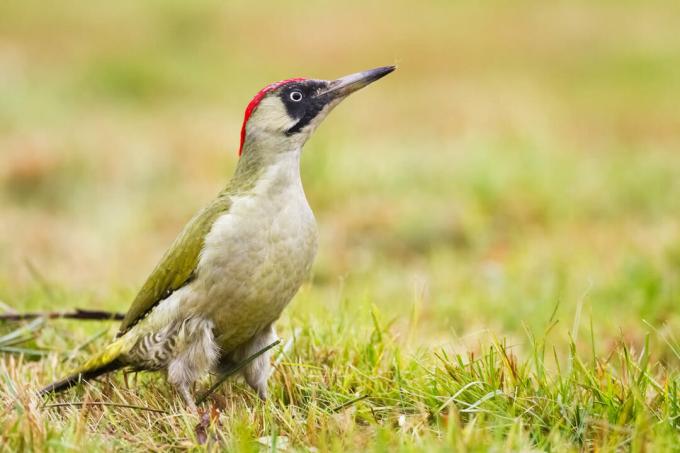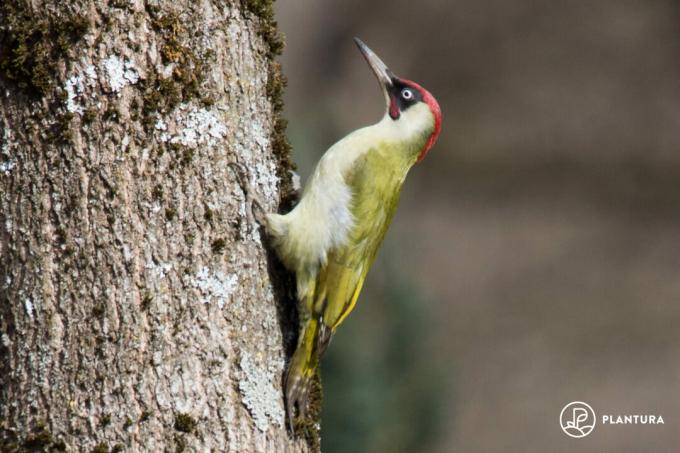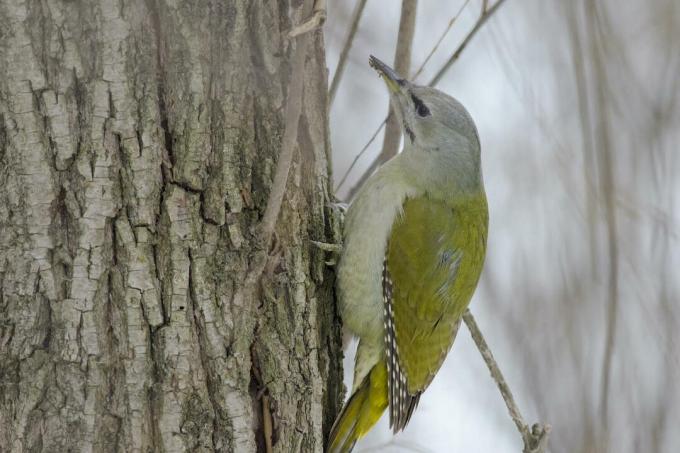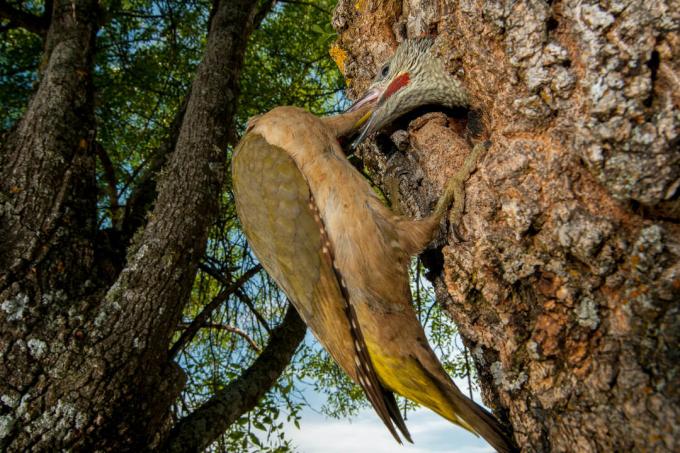How do you recognize a green woodpecker? How does his singing sound like? And how do you distinguish between male and female specimens? We answer these and other questions in our large green woodpecker profile.

The green woodpecker (Picus viridis) is the second most common native woodpecker after the great spotted woodpecker. It can be seen regularly in parks and gardens, where it likes to sit on the open ground or in the grass to look for its favorite food, the ants. Because of this peculiarity, the green woodpecker is also called the ground woodpecker or grass woodpecker. If he hides in the thick undergrowth, his loud, laughing singing can still be heard clearly in the spring. The green woodpecker has a broad habitat, which also includes orchards. As a proxy for all the species that find a home on these valuable areas and to respond to the threat and to draw attention to the increasing decline of this habitat, the green woodpecker was named "Bird of the Year 2014" chosen. You can find more interesting information on breeding, appearance and support options in our large profile on the topic of green woodpecker.
contents
- Profile of the green woodpecker
-
Recognize green woodpeckers
- How does the green woodpecker singing sound?
- How do you recognize young green woodpeckers?
- What do the eggs look like?
- How can one differentiate between female and male green woodpeckers?
- Where does the ground woodpecker live?
- How and where do green woodpeckers build their nests?
- When do green woodpeckers breed?
- Where does the ground woodpecker overwinter?
-
How can you support the green woodpecker in the garden?
- What food do green woodpeckers prefer?
- Are nest boxes suitable for the green woodpecker?
- How can you give him additional support?
Profile of the green woodpecker
| size | About 31 - 33 cm |
| weight | About 180 g |
| Breeding season | April June |
| lifespan | Up to 10 years |
| habitat | Forests, orchards, parks or gardens |
| Feed preference | Ants and their larvae |
| Threats | Decline in food and natural habitat |
Recognize green woodpeckers
The green woodpecker lives up to its name. It is easy to recognize by the moss green color of its back, wing and tail feathers. At over 30 centimeters, the ground woodpecker is also quite a large bird, which is characterized by its long, pointed beak, black face mask and bright red crown. In flight, the green woodpecker can also be recognized by the typical wave-like flight of the woodpecker, the bright yellow lower back, also called rump, and the black, white-dotted wings.

The green woodpecker can only be confused with the gray woodpecker, which has the same basic green color Compared to the green woodpecker, however, it is slightly smaller and has a gray head without a black face mask and red ones Parting.

How does the green woodpecker singing sound?
In contrast to the great spotted woodpecker, the green woodpecker rarely drums because its beak is less powerful and not so well suited for such exertions. Instead, the ground woodpecker makes himself heard with a loud, laughing song, which consists of a long stanza with a slightly sloping pitch: "Ha-ha-ha-ha-ha-ha-ha-ha-ha-ha". This characteristic bird's voice has earned the green woodpecker the nickname "laughing bird". In addition to its laughing song, the green woodpecker has a reputation that it sometimes gives off when it is in flight or when excited. The green woodpecker's call consists of a quick, excited stanza: “Kjück-kjück-kjück-kjück-kjück!”
You can hear the green woodpecker singing in this recording:

How do you recognize young green woodpeckers?
Young green woodpeckers are very easy to spot because they already look like small specimens from their parents. They differ from the adult animals only in the gray-spotted plumage on the face and stomach area, the lack of a black face mask and the somewhat spotty red crown.

What do the eggs look like?
The eggs of the green woodpecker measure around 31 x 23 millimeters and are brilliant white. The females lay between five and eight eggs per clutch in an existing or self-made tree cavity.
How can one differentiate between female and male green woodpeckers?
Female and male green woodpeckers look the same at first glance. Only when you take a closer look you can see the small but subtle difference: the streak of beard that extends from the rear edge of the The beak pulls towards the neck is solid black in the females - in the males, however, it is bright red filled out.

Where does the ground woodpecker live?
The habitat of the green woodpecker is very variable, but it prefers a somewhat open landscape. The green woodpecker is found in orchards, in parks and large gardens. It also feels at home in deciduous or mixed forests, but there it tends to colonize forest edges, clearings or other more open areas.
How and where do green woodpeckers build their nests?
Green woodpeckers like to use other woodpeckers' existing burrows because they have one fewer than other species have a strong beak that is better suited for foraging in soft wood and soil than for powerful hammering is. If there is no such cave, the green woodpecker will still put a hand - or a beak - on. Then he prefers to use soft wood or trees that are already sick to build his breeding cave. This work is mainly done by the males and can take up to three weeks. The breeding cave itself is about 50 centimeters deep at the end and has a slightly oval entrance hole measuring about six by seven centimeters.
When do green woodpeckers breed?
The female green woodpecker lays her eggs in April and then incubates them for about two weeks. The fledglings depend on the care of their parents for 23 to 27 days after hatching before leaving the nest. And even then, their parents continue to look after them and help them find food for up to seven weeks. Green woodpeckers only have a second brood if the first offspring does not survive.

Where does the ground woodpecker overwinter?
Green woodpeckers are very local birds. They only leave their breeding area within a few kilometers, even in winter, and do not move south. Instead, they roam the cold landscape as loners looking for food. Ant nests are their favorite food source. The green woodpeckers can even find them under a thick blanket of snow.
How can you support the green woodpecker in the garden?
It is not uncommon for the green woodpecker to be seen in large gardens and parks. Due to the progressive loss of semi-open habitats such as orchards or sparse mixed forests, the laughing bird is increasingly dependent on these secondary habitats. If you want to make it a little more pleasant for the domestic bird in your own garden, you will find some tips below on how you can support the green woodpecker.
What food do green woodpeckers prefer?
Green woodpeckers love ants. The small insects and their larvae are the main food of the pretty birds. Once they have found an ant nest, they often return there many times to satisfy their appetite and can be easily observed. They dig holes in the anthill with their beak and use their long, sticky tongues to pick up the little creatures. Even in winter and under a thick blanket of snow, they can find these food sources again. When there is a shortage of ants, the green woodpeckers resort to other insects, which they peck from tree bark.

Are nest boxes suitable for the green woodpecker?
In theory, green woodpeckers are cave breeders who like to accept existing caves and therefore could actually be well supported with spacious full-cave nesting boxes. Unfortunately, however, in practice it has proven very difficult to develop nesting boxes that are actually accepted by green woodpeckers. Hanging up a nesting box for green woodpeckers is therefore rather a wasted effort. Here it makes more sense to focus on the species that you can actually support with nesting boxes, such as Blue tits, Starlings or Wrens.
How can you give him additional support?
So you cannot support the green woodpecker in its breeding process with nesting boxes. If you have the opportunity, however, you can arrange for natural nesting sites. For example, think carefully about whether a somewhat sick or rotten tree really has to go or whether it can be used as a breeding ground for a woodpecker.
The natural food supply can also be promoted by transforming your garden into a paradise for insects and ants. Even if people do not like to see ants in the garden, the small animals are very important as food for many birds. In addition, the beneficial insects loosen our soil and thus ensure a smooth cycle of materials. It is therefore worthwhile to think twice about whether ants can be driven out of the garden with chemical agents, which can also harm many other animals. If, on the other hand, you want to go a step further and bring more life to your garden, you can do this with our, for example Plantura beneficial insect magnet succeed. In this way you can create a true paradise for small garden visitors, for which the green woodpeckers will also thank you.
It is even more common than the green woodpecker great spotted woodpecker visiting our gardens. Have a look at his profile and learn more about native woodpeckers.



